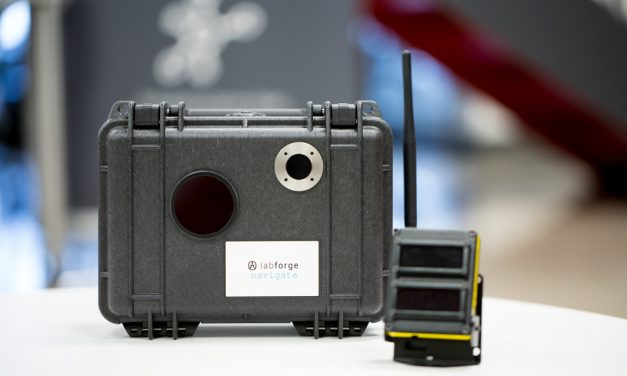Last summer, just a few weeks after the Royal Canadian Air Force had opened its corporate innovation lab at Communitech, Capt. Jean Lebouthillier decided to go on a bit of a “recce.”
A recce is a reconnaissance, something Canadian Armed Forces personnel routinely undertake in order to get the lay of the land and assess a situation before embarking on a mission or project.
In this case, the recce was of the local, and walking, variety. Capt. Lebouthillier, newly installed as the RCAF’s acting lab director, was keen to get to know his Tannery neighbours, and as he walked through the University of Waterloo Velocity space on the first floor, a startup called Labforge caught his eye.
Labforge is a four-year-old company that makes an AI-fuelled sensing and security platform capable of monitoring activity and detecting threats from land and air. The air force just happens to be in the business of monitoring activity and detecting threats from the land and the air.
Lebouthillier went back to his desk and promptly wrote a one-page summary about Labforge’s product and fired it up the chain of command.
Fast-forward to March 19, when Labforge received word that, on the strength of the air force’s interest in its product, it had gained acceptance into the federal government’s Build in Canada Innovation Program (BCIP), which connects startups with federal government departments looking to innovate; Labforge will receive $1 million from BCIP and the RCAF will gain access to Labforge’s sensor product for testing, which it hopes to begin at some of its bases here in Canada as early as this spring, if possible.

The Labforge perimeter security user interface. People, vehicles and aircraft are distinguished by
different symbols. (Communitech photo: Sara Jalali)
“[This] has the potential to change things – a lot,” says Maj. James Pierotti, Innovation Section Head with the RCAF’s Aerospace Warfare Centre at CFB Trenton.
The air force opened its innovation lab, which it calls The Flight Deck, with the twin aims of retooling the way it approaches technology and to be on the lookout for startups that can help it solve real-world problems.
Labforge’s technology appears to fit the bill, and then some.
Its product is able to distinguish between friend and foe, can identify threats from the air as well as land, and the sensors are quick and easy to deploy. When combined with its intelligent user interface, the system is capable of painting a real-time electronic picture of a given environment, giving its users instant situational awareness.
It’s a giant leap in capability from that provided by an attendant staring into a traditional video camera monitor, or a series of monitors. Labforge’s product doesn’t need to go for coffee, doesn’t need to sleep, and doesn’t glaze over after hours of monotony, staring at a screen.
And it not only provides far better security and awareness, it provides it with far fewer personnel.
“Imagine we’ve got a helicopter footprint [deployed] somewhere, and we need to provide force protection,” says Maj. Pierotti. “We need to make sure those assets are secure, day and night, 24/7. So how is that currently conducted?
“Depending on the footprint, we could have up to a platoon of army personnel that do regular patrols, or set up closed-circuit TV cameras, and then we’ve got someone monitoring and looking at each camera.
“So, [it’s] personnel intensive, at a time when personnel is one of our big [issues]. We’re short on numbers.
“So the potential benefit of this technology is to reduce the number of people that are involved in monitoring and responding to threats against our aircraft.”
Sgt. Ted Van Hezewyk, the Flight Deck’s Concept Development & Experimentation Innovation Supervisor, says he can envision the technology being used at existing Canadian air force bases, like the one in Cold Lake, Alta., to keep an eye threats as relatively benign as wildlife breaking through a perimeter fence, as well as during aircraft deployments overseas, where the stakes are higher: The sensors are portable, easy to deploy and relatively inexpensive.

Labforge sensors work in tandem, relaying information to users.
They’re small, portable and easy to set up and replace. (Communitech photo: Sara Jalali)
“If somebody shoots [a sensor], or one freezes or breaks, you’ve got immediate redundancy,” says Maj. Pierotti. “[If you need to replace a sensor], you can just strap it to a tree or strap it to a fence. This quick-and-easy replacement, movement, portability, is absolutely game-changing, or potentially game-changing, from our perspective.
“We want to test if that is true.”
Another key capability of the product is its ability to detect threats from the air, something with which a traditional video monitoring system can’t cope.
“This [technology] makes it that much easier to recognize U.A.S., or unmanned aerial systems, which is a big deal,” says Maj. Pierotti. “It potentially gives you the time you need to do something about [an aerial threat].
“That’s why we’re deeply interested.”
So, too, are other branches of the Canadian military.
It’s not the first time that a nimble startup has partnered with Communitech corporate innovation client looking to change and modernize, to the net benefit of both.
Last September, Canadian Tire (which has since moved out of the Tannery but maintains an innovation footprint nearby), completed an agreement to stock products made by startup Alert Labs in some of its Ontario stores.
For their part, Labforge’s team members, as you would imagine, are delighted with the RCAF partnership. The agreement not only gets them access to capital, it provides them with a reference customer for their product.
“This is great for us in terms of showcasing our capabilities in a harsh environment,” says Labforge CEO Yassir Rizwan.
“We’ve built a really good relationship with the air force. The Flight Deck has been extremely helpful.”
Rizwan is hopeful of eventually selling Labforge’s product to power plants, solar farms, seaports and warehouses.
“We’ve already started conversations with them and now those conversations become a lot easier.”

